Organizational Change Management Report: Rolls Royce Analysis
VerifiedAdded on 2020/05/28
|23
|5793
|63
Report
AI Summary
This business report analyzes the change management strategies implemented by Rolls Royce, focusing on the context, culture, and drivers for change within the organization. The report identifies the company's shift from a centralized to a decentralized structure, the division of the organization into five operational units, and the reduction in management hierarchy. It examines the use of the Lewin Change Model and the ADKAR model to implement these changes, while also addressing significant barriers such as employee resistance and operational challenges. The report highlights Rolls Royce's response to profit warnings and the need to improve investor confidence, as well as the strategies used to overcome these challenges. The analysis includes the impact of these changes on the company's structure, culture, and overall performance, offering insights into the complexities of organizational transformation.
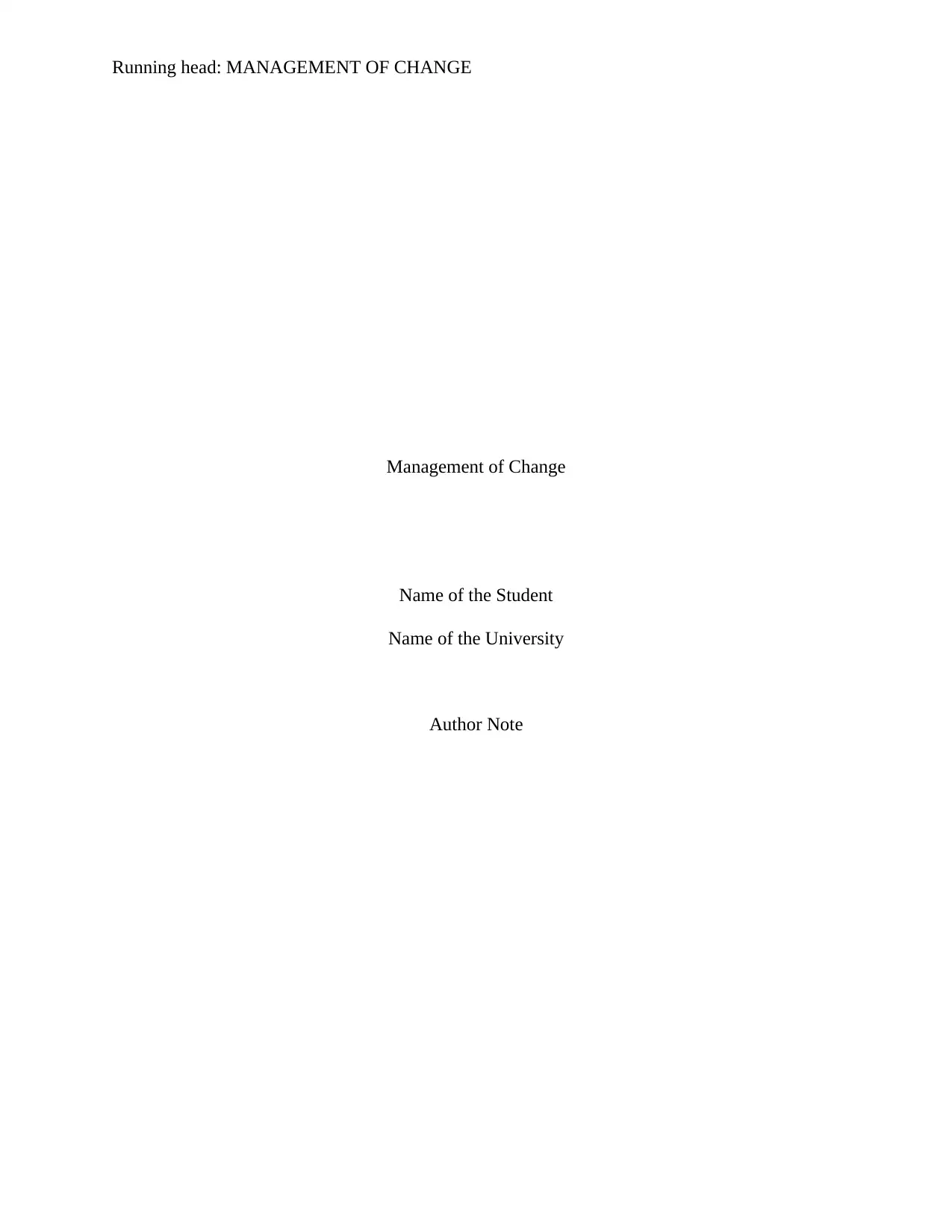
Running head: MANAGEMENT OF CHANGE
Management of Change
Name of the Student
Name of the University
Author Note
Management of Change
Name of the Student
Name of the University
Author Note
Paraphrase This Document
Need a fresh take? Get an instant paraphrase of this document with our AI Paraphraser

1MANAGEMENT OF CHANGE
Executive Summary
The major aim of this business report is to identify the sources of change affecting organizations,
nature of organizational change and relevance of different organizational forms. The
organizational that is considered for the report is Rolls Royce. The context, culture and drivers
for change implemented in the organization are also identified along with the justification of the
plan for the implementation of successful change to overcome the barrier of the same. Lewin
Change Model and ADKAR model is utilized for highlighting the changes implemented for the
organization. It is found from the report assessment that Rolls Royce has faced five profit
warning in two years and the major reason is due to the less interest of the investor for investing
the financial resources. The reason found for this issue is the lack of ability in the aerospace
division for making the investors understands the necessary business process regarding the
manufacturing and designing of the automobiles. Another problem identified is the involvement
of more cost in maintaining multiple managerial hierarchies which is overcome through removal
of the managing hierarchy. Another change management that is identified in this report is
classification of the organizational divisions from two to five so as to simplify the managing
operation of the organization.
Executive Summary
The major aim of this business report is to identify the sources of change affecting organizations,
nature of organizational change and relevance of different organizational forms. The
organizational that is considered for the report is Rolls Royce. The context, culture and drivers
for change implemented in the organization are also identified along with the justification of the
plan for the implementation of successful change to overcome the barrier of the same. Lewin
Change Model and ADKAR model is utilized for highlighting the changes implemented for the
organization. It is found from the report assessment that Rolls Royce has faced five profit
warning in two years and the major reason is due to the less interest of the investor for investing
the financial resources. The reason found for this issue is the lack of ability in the aerospace
division for making the investors understands the necessary business process regarding the
manufacturing and designing of the automobiles. Another problem identified is the involvement
of more cost in maintaining multiple managerial hierarchies which is overcome through removal
of the managing hierarchy. Another change management that is identified in this report is
classification of the organizational divisions from two to five so as to simplify the managing
operation of the organization.
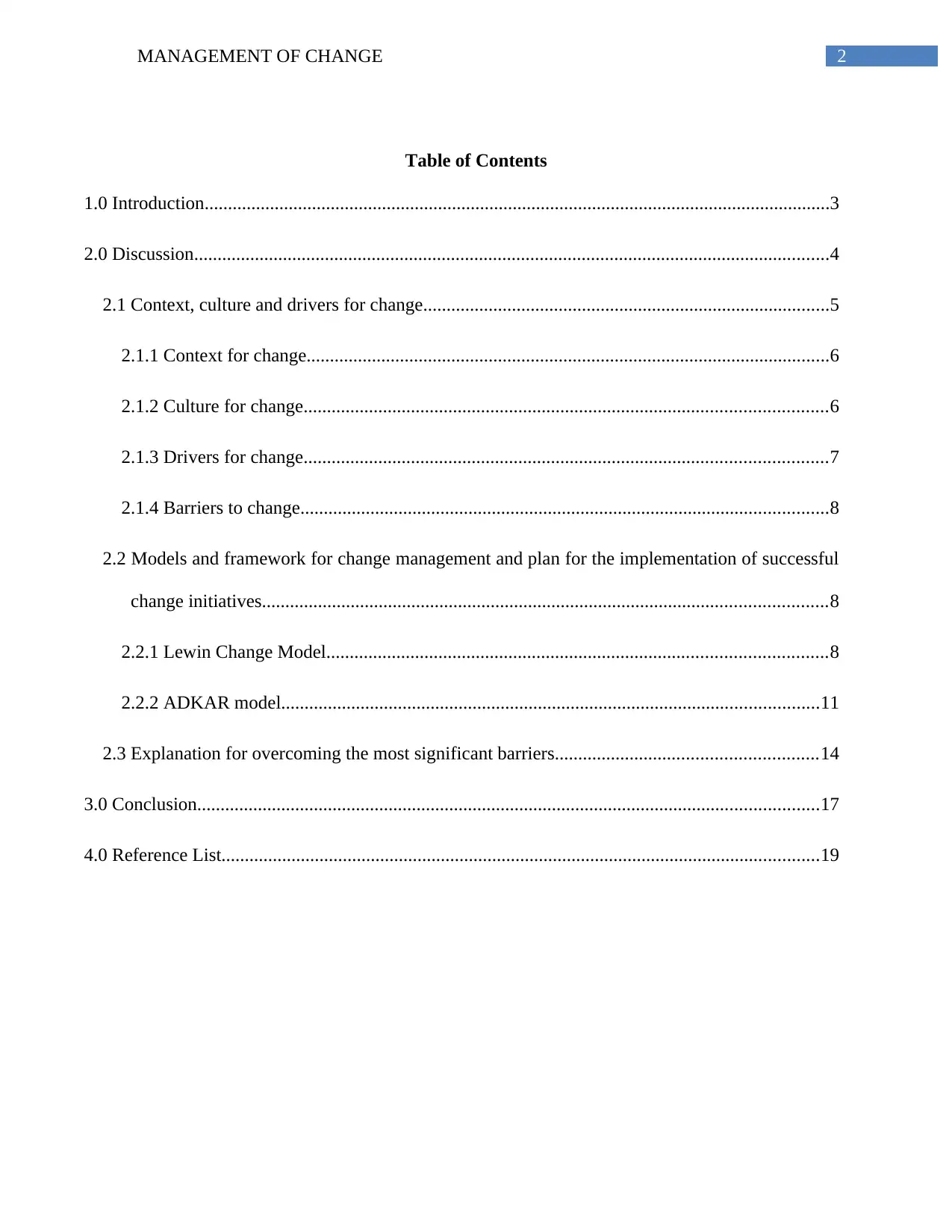
2MANAGEMENT OF CHANGE
Table of Contents
1.0 Introduction......................................................................................................................................3
2.0 Discussion........................................................................................................................................4
2.1 Context, culture and drivers for change.......................................................................................5
2.1.1 Context for change................................................................................................................6
2.1.2 Culture for change................................................................................................................6
2.1.3 Drivers for change................................................................................................................7
2.1.4 Barriers to change.................................................................................................................8
2.2 Models and framework for change management and plan for the implementation of successful
change initiatives.........................................................................................................................8
2.2.1 Lewin Change Model...........................................................................................................8
2.2.2 ADKAR model...................................................................................................................11
2.3 Explanation for overcoming the most significant barriers........................................................14
3.0 Conclusion.....................................................................................................................................17
4.0 Reference List................................................................................................................................19
Table of Contents
1.0 Introduction......................................................................................................................................3
2.0 Discussion........................................................................................................................................4
2.1 Context, culture and drivers for change.......................................................................................5
2.1.1 Context for change................................................................................................................6
2.1.2 Culture for change................................................................................................................6
2.1.3 Drivers for change................................................................................................................7
2.1.4 Barriers to change.................................................................................................................8
2.2 Models and framework for change management and plan for the implementation of successful
change initiatives.........................................................................................................................8
2.2.1 Lewin Change Model...........................................................................................................8
2.2.2 ADKAR model...................................................................................................................11
2.3 Explanation for overcoming the most significant barriers........................................................14
3.0 Conclusion.....................................................................................................................................17
4.0 Reference List................................................................................................................................19
⊘ This is a preview!⊘
Do you want full access?
Subscribe today to unlock all pages.

Trusted by 1+ million students worldwide

3MANAGEMENT OF CHANGE
1.0 Introduction
Hornstein (2015) depict that the transition or transformation of an organization's goals,
technology and processes adopted by an organization is known as change management. The
major purpose of the change management is to implement effective changes, controlling the
change and enhance the capability of the employees for accepting the change. Benn et al. (2014)
on the other hand argued that employee of the organization sometimes is not ready to accept the
change and it impacts their performance which furthermore affects the profitability of the
organization. This business report is presented through the perception of the external change
management agent as this will provide more genuine critical analysis of the implemented change.
The company hires this agent as a third party agent during the change management.
In this business report, the organization selected for evaluating their change management
is Rolls Royce. Rolls Royce is an aerospace and motor vehicle manufacturing and design
company that formulates civil and military aero engines, automobiles, power generation
equipment and marine propulsion system (BBC News 2018). However, in the year 2015, the
management of the concerned organization intends to omit the top layer of management in order
to simplify the decision-making processes for the organization. This assessment aims for
identifying the sources of change affecting organizations, nature of organizational change and
relevance of different organizational forms. In this report, the context, culture and drivers for
change implemented in the organization is identified followed by the detailed description of a
plan for the implementation of successful change to overcome the barrier of the same. A range of
diagnostic models and frameworks will be applied to justify the plan for implementation of the
change. Lastly, the report illustrated to overcome the significant barriers that are raised while
implementing the change which is followed by a conclusion based on the entire discussion.
1.0 Introduction
Hornstein (2015) depict that the transition or transformation of an organization's goals,
technology and processes adopted by an organization is known as change management. The
major purpose of the change management is to implement effective changes, controlling the
change and enhance the capability of the employees for accepting the change. Benn et al. (2014)
on the other hand argued that employee of the organization sometimes is not ready to accept the
change and it impacts their performance which furthermore affects the profitability of the
organization. This business report is presented through the perception of the external change
management agent as this will provide more genuine critical analysis of the implemented change.
The company hires this agent as a third party agent during the change management.
In this business report, the organization selected for evaluating their change management
is Rolls Royce. Rolls Royce is an aerospace and motor vehicle manufacturing and design
company that formulates civil and military aero engines, automobiles, power generation
equipment and marine propulsion system (BBC News 2018). However, in the year 2015, the
management of the concerned organization intends to omit the top layer of management in order
to simplify the decision-making processes for the organization. This assessment aims for
identifying the sources of change affecting organizations, nature of organizational change and
relevance of different organizational forms. In this report, the context, culture and drivers for
change implemented in the organization is identified followed by the detailed description of a
plan for the implementation of successful change to overcome the barrier of the same. A range of
diagnostic models and frameworks will be applied to justify the plan for implementation of the
change. Lastly, the report illustrated to overcome the significant barriers that are raised while
implementing the change which is followed by a conclusion based on the entire discussion.
Paraphrase This Document
Need a fresh take? Get an instant paraphrase of this document with our AI Paraphraser
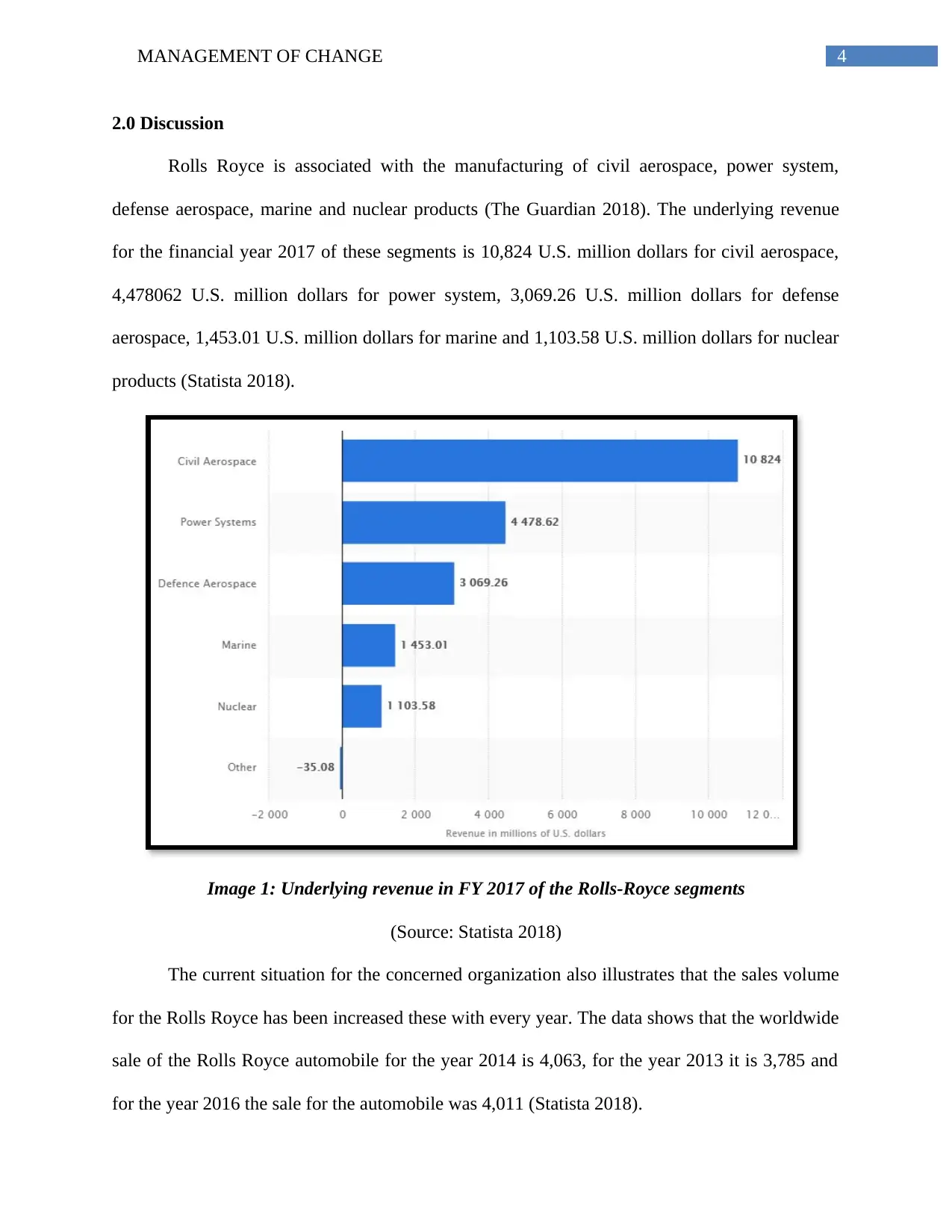
4MANAGEMENT OF CHANGE
2.0 Discussion
Rolls Royce is associated with the manufacturing of civil aerospace, power system,
defense aerospace, marine and nuclear products (The Guardian 2018). The underlying revenue
for the financial year 2017 of these segments is 10,824 U.S. million dollars for civil aerospace,
4,478062 U.S. million dollars for power system, 3,069.26 U.S. million dollars for defense
aerospace, 1,453.01 U.S. million dollars for marine and 1,103.58 U.S. million dollars for nuclear
products (Statista 2018).
Image 1: Underlying revenue in FY 2017 of the Rolls-Royce segments
(Source: Statista 2018)
The current situation for the concerned organization also illustrates that the sales volume
for the Rolls Royce has been increased these with every year. The data shows that the worldwide
sale of the Rolls Royce automobile for the year 2014 is 4,063, for the year 2013 it is 3,785 and
for the year 2016 the sale for the automobile was 4,011 (Statista 2018).
2.0 Discussion
Rolls Royce is associated with the manufacturing of civil aerospace, power system,
defense aerospace, marine and nuclear products (The Guardian 2018). The underlying revenue
for the financial year 2017 of these segments is 10,824 U.S. million dollars for civil aerospace,
4,478062 U.S. million dollars for power system, 3,069.26 U.S. million dollars for defense
aerospace, 1,453.01 U.S. million dollars for marine and 1,103.58 U.S. million dollars for nuclear
products (Statista 2018).
Image 1: Underlying revenue in FY 2017 of the Rolls-Royce segments
(Source: Statista 2018)
The current situation for the concerned organization also illustrates that the sales volume
for the Rolls Royce has been increased these with every year. The data shows that the worldwide
sale of the Rolls Royce automobile for the year 2014 is 4,063, for the year 2013 it is 3,785 and
for the year 2016 the sale for the automobile was 4,011 (Statista 2018).

5MANAGEMENT OF CHANGE
Image 2: Worldwide sales volume of Rolls-Royce automobiles
(Source: Statista 2018)
2.1 Context, culture and drivers for change
The change that the company Rolls-Royce implemented in their organization is to
remove the top management so that the company can feel easy in taking decision for business
operations. Apart from the decision of simplifying the organizational structure, the company
planned to operate with five divisions- civil aerospace, defense aerospace, marine, nuclear, and
power systems (The Guardian 2018). The five division of the company is formulated by
scrapping two divisions to turnaround the struggling engineer. This plan was also include the job
cuts of 2,600 in the next 18 months from the decision (BBC News 2018). During the time 2014,
Rolls-Royce's global workforce shows the figure of 55,000 out of which 24,000 workers are
alone working in the UK (BBC News 2018). The job cut had been planned mainly for the
Image 2: Worldwide sales volume of Rolls-Royce automobiles
(Source: Statista 2018)
2.1 Context, culture and drivers for change
The change that the company Rolls-Royce implemented in their organization is to
remove the top management so that the company can feel easy in taking decision for business
operations. Apart from the decision of simplifying the organizational structure, the company
planned to operate with five divisions- civil aerospace, defense aerospace, marine, nuclear, and
power systems (The Guardian 2018). The five division of the company is formulated by
scrapping two divisions to turnaround the struggling engineer. This plan was also include the job
cuts of 2,600 in the next 18 months from the decision (BBC News 2018). During the time 2014,
Rolls-Royce's global workforce shows the figure of 55,000 out of which 24,000 workers are
alone working in the UK (BBC News 2018). The job cut had been planned mainly for the
⊘ This is a preview!⊘
Do you want full access?
Subscribe today to unlock all pages.

Trusted by 1+ million students worldwide

6MANAGEMENT OF CHANGE
aerospace divisions and 800-1200 engineering jobs cut were made in Bristol and Derby (BBC
News 2018).
2.1.1 Context for change
The main context of the change in the Rolls Royce is the estimation of series of profit
warnings which impact their market share (BBC News 2018). The share price for the company in
the year 2015 comes down to 38% and the company intends to make the company once again the
largest profit earning organization (Mail Online 2018). The company also noted that the
engineering group employed in the organization did not provide clear idea on the projects that
left investors unclear about its direction due to which the company faces much loss in profits and
business partnerships (BBC News 2018).
2.1.2 Culture for change
Kaufman (2017) stated that the culture of change represents the process and belief
followed in the organizations changes due to some reasons. In case of Rolls Royce, there are two
types cultural change identified in the organization- one in term of management and other for the
employees. In traditional times, Rolls Royce had centralized organizational structure, where
there are many hierarchies that delay the process that is implemented in the organization. Thus,
in order to remove the barriers of the ease in decision making process, the hierarchy are planned
to remove. The organization thus changed their organizational structure from centralized to de-
centralize. Lunenburg (2012) stated that the major advantage of a de-centralized organization is
that the employees or their immediate managers also have the power to participate in the
decision making sessions, maintenance of self-sufficiency as both managers and employees are
working autonomously and facilitating the process of expansion.
aerospace divisions and 800-1200 engineering jobs cut were made in Bristol and Derby (BBC
News 2018).
2.1.1 Context for change
The main context of the change in the Rolls Royce is the estimation of series of profit
warnings which impact their market share (BBC News 2018). The share price for the company in
the year 2015 comes down to 38% and the company intends to make the company once again the
largest profit earning organization (Mail Online 2018). The company also noted that the
engineering group employed in the organization did not provide clear idea on the projects that
left investors unclear about its direction due to which the company faces much loss in profits and
business partnerships (BBC News 2018).
2.1.2 Culture for change
Kaufman (2017) stated that the culture of change represents the process and belief
followed in the organizations changes due to some reasons. In case of Rolls Royce, there are two
types cultural change identified in the organization- one in term of management and other for the
employees. In traditional times, Rolls Royce had centralized organizational structure, where
there are many hierarchies that delay the process that is implemented in the organization. Thus,
in order to remove the barriers of the ease in decision making process, the hierarchy are planned
to remove. The organization thus changed their organizational structure from centralized to de-
centralize. Lunenburg (2012) stated that the major advantage of a de-centralized organization is
that the employees or their immediate managers also have the power to participate in the
decision making sessions, maintenance of self-sufficiency as both managers and employees are
working autonomously and facilitating the process of expansion.
Paraphrase This Document
Need a fresh take? Get an instant paraphrase of this document with our AI Paraphraser
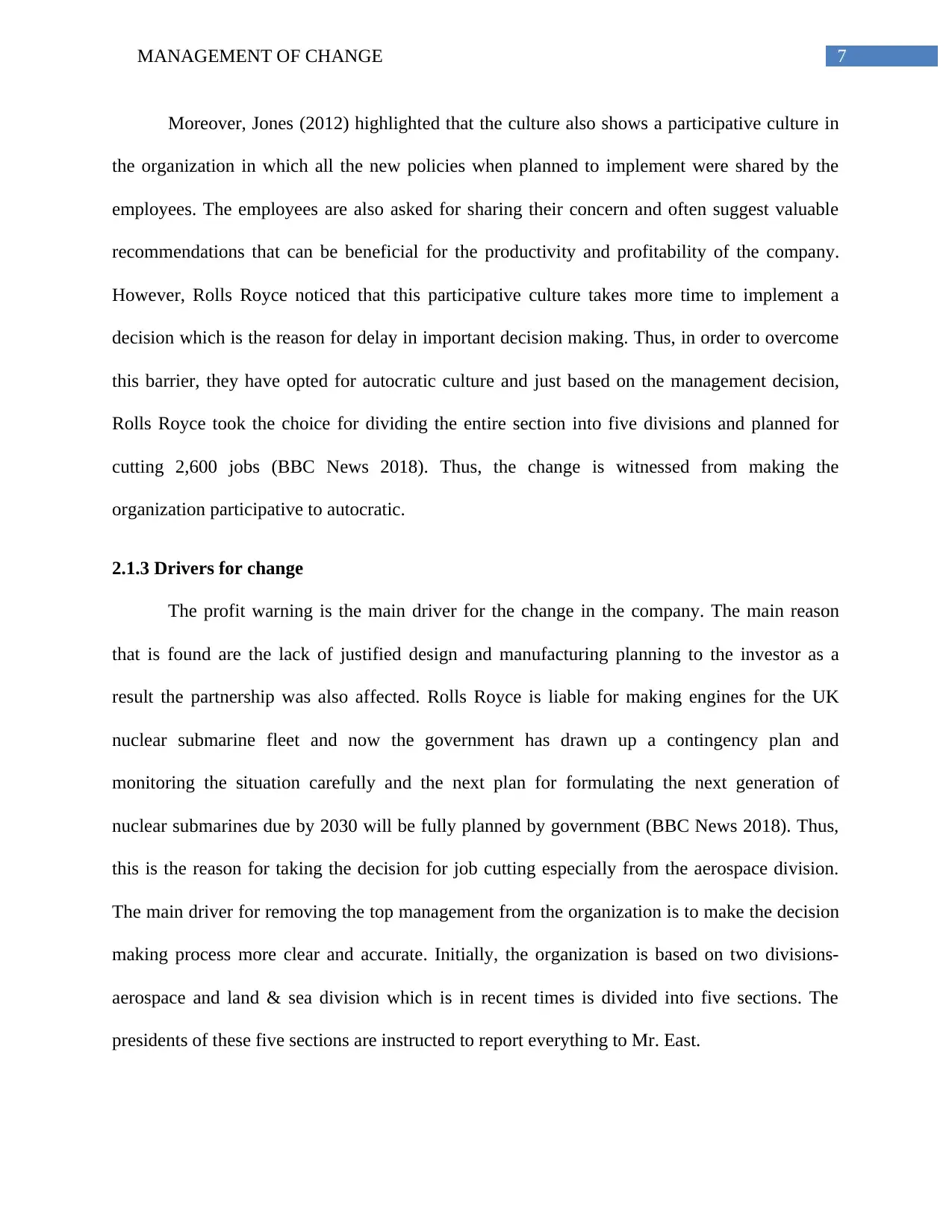
7MANAGEMENT OF CHANGE
Moreover, Jones (2012) highlighted that the culture also shows a participative culture in
the organization in which all the new policies when planned to implement were shared by the
employees. The employees are also asked for sharing their concern and often suggest valuable
recommendations that can be beneficial for the productivity and profitability of the company.
However, Rolls Royce noticed that this participative culture takes more time to implement a
decision which is the reason for delay in important decision making. Thus, in order to overcome
this barrier, they have opted for autocratic culture and just based on the management decision,
Rolls Royce took the choice for dividing the entire section into five divisions and planned for
cutting 2,600 jobs (BBC News 2018). Thus, the change is witnessed from making the
organization participative to autocratic.
2.1.3 Drivers for change
The profit warning is the main driver for the change in the company. The main reason
that is found are the lack of justified design and manufacturing planning to the investor as a
result the partnership was also affected. Rolls Royce is liable for making engines for the UK
nuclear submarine fleet and now the government has drawn up a contingency plan and
monitoring the situation carefully and the next plan for formulating the next generation of
nuclear submarines due by 2030 will be fully planned by government (BBC News 2018). Thus,
this is the reason for taking the decision for job cutting especially from the aerospace division.
The main driver for removing the top management from the organization is to make the decision
making process more clear and accurate. Initially, the organization is based on two divisions-
aerospace and land & sea division which is in recent times is divided into five sections. The
presidents of these five sections are instructed to report everything to Mr. East.
Moreover, Jones (2012) highlighted that the culture also shows a participative culture in
the organization in which all the new policies when planned to implement were shared by the
employees. The employees are also asked for sharing their concern and often suggest valuable
recommendations that can be beneficial for the productivity and profitability of the company.
However, Rolls Royce noticed that this participative culture takes more time to implement a
decision which is the reason for delay in important decision making. Thus, in order to overcome
this barrier, they have opted for autocratic culture and just based on the management decision,
Rolls Royce took the choice for dividing the entire section into five divisions and planned for
cutting 2,600 jobs (BBC News 2018). Thus, the change is witnessed from making the
organization participative to autocratic.
2.1.3 Drivers for change
The profit warning is the main driver for the change in the company. The main reason
that is found are the lack of justified design and manufacturing planning to the investor as a
result the partnership was also affected. Rolls Royce is liable for making engines for the UK
nuclear submarine fleet and now the government has drawn up a contingency plan and
monitoring the situation carefully and the next plan for formulating the next generation of
nuclear submarines due by 2030 will be fully planned by government (BBC News 2018). Thus,
this is the reason for taking the decision for job cutting especially from the aerospace division.
The main driver for removing the top management from the organization is to make the decision
making process more clear and accurate. Initially, the organization is based on two divisions-
aerospace and land & sea division which is in recent times is divided into five sections. The
presidents of these five sections are instructed to report everything to Mr. East.
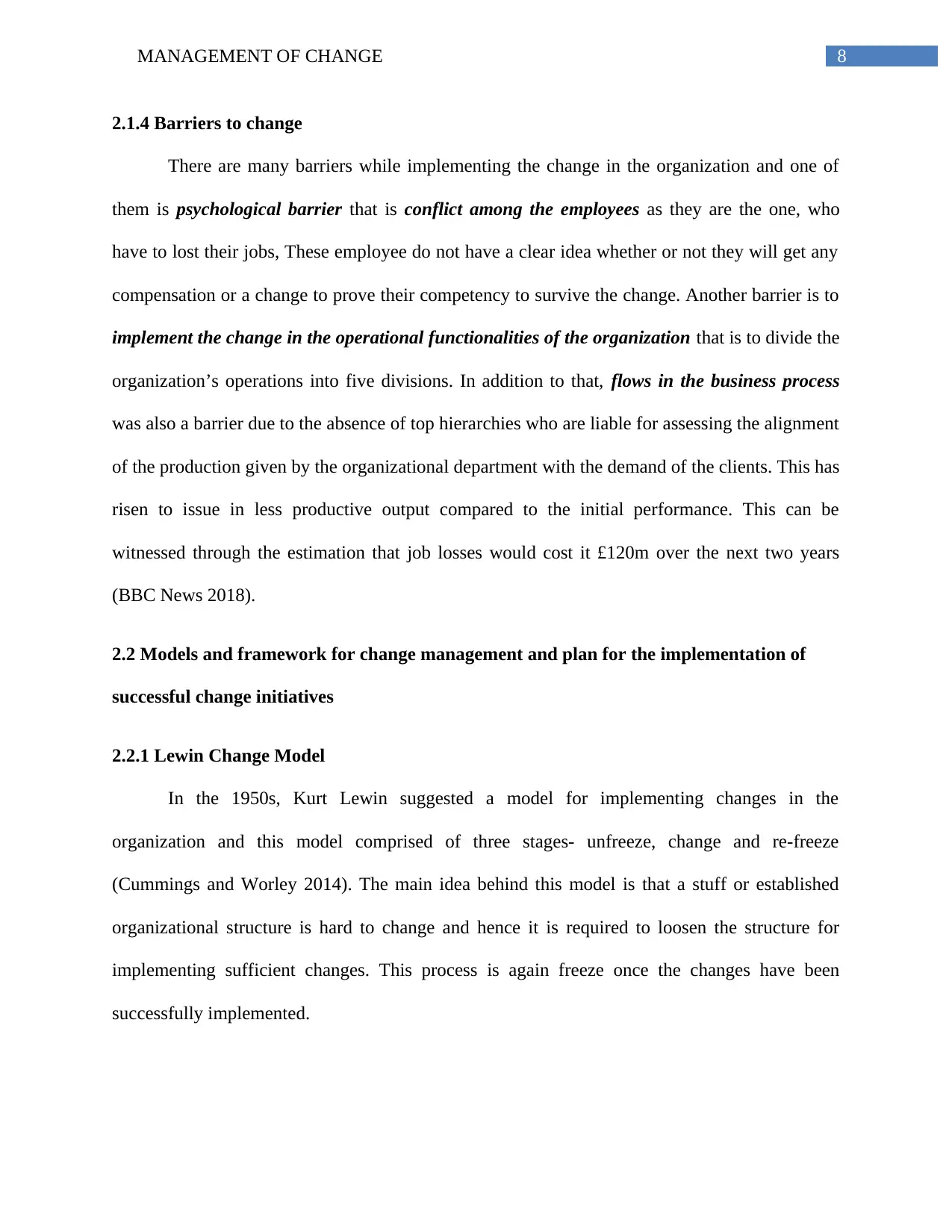
8MANAGEMENT OF CHANGE
2.1.4 Barriers to change
There are many barriers while implementing the change in the organization and one of
them is psychological barrier that is conflict among the employees as they are the one, who
have to lost their jobs, These employee do not have a clear idea whether or not they will get any
compensation or a change to prove their competency to survive the change. Another barrier is to
implement the change in the operational functionalities of the organization that is to divide the
organization’s operations into five divisions. In addition to that, flows in the business process
was also a barrier due to the absence of top hierarchies who are liable for assessing the alignment
of the production given by the organizational department with the demand of the clients. This has
risen to issue in less productive output compared to the initial performance. This can be
witnessed through the estimation that job losses would cost it £120m over the next two years
(BBC News 2018).
2.2 Models and framework for change management and plan for the implementation of
successful change initiatives
2.2.1 Lewin Change Model
In the 1950s, Kurt Lewin suggested a model for implementing changes in the
organization and this model comprised of three stages- unfreeze, change and re-freeze
(Cummings and Worley 2014). The main idea behind this model is that a stuff or established
organizational structure is hard to change and hence it is required to loosen the structure for
implementing sufficient changes. This process is again freeze once the changes have been
successfully implemented.
2.1.4 Barriers to change
There are many barriers while implementing the change in the organization and one of
them is psychological barrier that is conflict among the employees as they are the one, who
have to lost their jobs, These employee do not have a clear idea whether or not they will get any
compensation or a change to prove their competency to survive the change. Another barrier is to
implement the change in the operational functionalities of the organization that is to divide the
organization’s operations into five divisions. In addition to that, flows in the business process
was also a barrier due to the absence of top hierarchies who are liable for assessing the alignment
of the production given by the organizational department with the demand of the clients. This has
risen to issue in less productive output compared to the initial performance. This can be
witnessed through the estimation that job losses would cost it £120m over the next two years
(BBC News 2018).
2.2 Models and framework for change management and plan for the implementation of
successful change initiatives
2.2.1 Lewin Change Model
In the 1950s, Kurt Lewin suggested a model for implementing changes in the
organization and this model comprised of three stages- unfreeze, change and re-freeze
(Cummings and Worley 2014). The main idea behind this model is that a stuff or established
organizational structure is hard to change and hence it is required to loosen the structure for
implementing sufficient changes. This process is again freeze once the changes have been
successfully implemented.
⊘ This is a preview!⊘
Do you want full access?
Subscribe today to unlock all pages.

Trusted by 1+ million students worldwide

9MANAGEMENT OF CHANGE
Image 3: Lewin’s for change management
(Source: Cummings and Worley 2014)
Identified areas for the changes made in the company
Unfreeze- Appelbaum et al. (2012) stated that Lewin discussed that this is the preparation stage,
where the company show your employees and convince them that the changes in important. Jabri
(2017) furthermore depicted that this process also focuses on the values and culture of the
company and the management is responsible to check for the changes occurred in the
organizational process. Rolls Royce identify the change in the management hierarchy in this
section along with the planning that for dividing the entire organization into five parts which was
initially two in number that is aerospace and Land-&-Sea (BBC News 2018).
Change- Erakovich and Anderson (2013) highlighted that in this aspect, the stakeholder of the
company accept and adopt the change. Rolls Royce makes the change in terms of not hiring any
new head for aerospace section after the departure of Tony Wood, president of the aerospace
division and made Lawrie Haynes, financial officer the president of land & sea as the new head
of the entire group who is also liable for giving business related suggestion directly to Mr.
Warren East (The Guardian 2018).
Image 3: Lewin’s for change management
(Source: Cummings and Worley 2014)
Identified areas for the changes made in the company
Unfreeze- Appelbaum et al. (2012) stated that Lewin discussed that this is the preparation stage,
where the company show your employees and convince them that the changes in important. Jabri
(2017) furthermore depicted that this process also focuses on the values and culture of the
company and the management is responsible to check for the changes occurred in the
organizational process. Rolls Royce identify the change in the management hierarchy in this
section along with the planning that for dividing the entire organization into five parts which was
initially two in number that is aerospace and Land-&-Sea (BBC News 2018).
Change- Erakovich and Anderson (2013) highlighted that in this aspect, the stakeholder of the
company accept and adopt the change. Rolls Royce makes the change in terms of not hiring any
new head for aerospace section after the departure of Tony Wood, president of the aerospace
division and made Lawrie Haynes, financial officer the president of land & sea as the new head
of the entire group who is also liable for giving business related suggestion directly to Mr.
Warren East (The Guardian 2018).
Paraphrase This Document
Need a fresh take? Get an instant paraphrase of this document with our AI Paraphraser
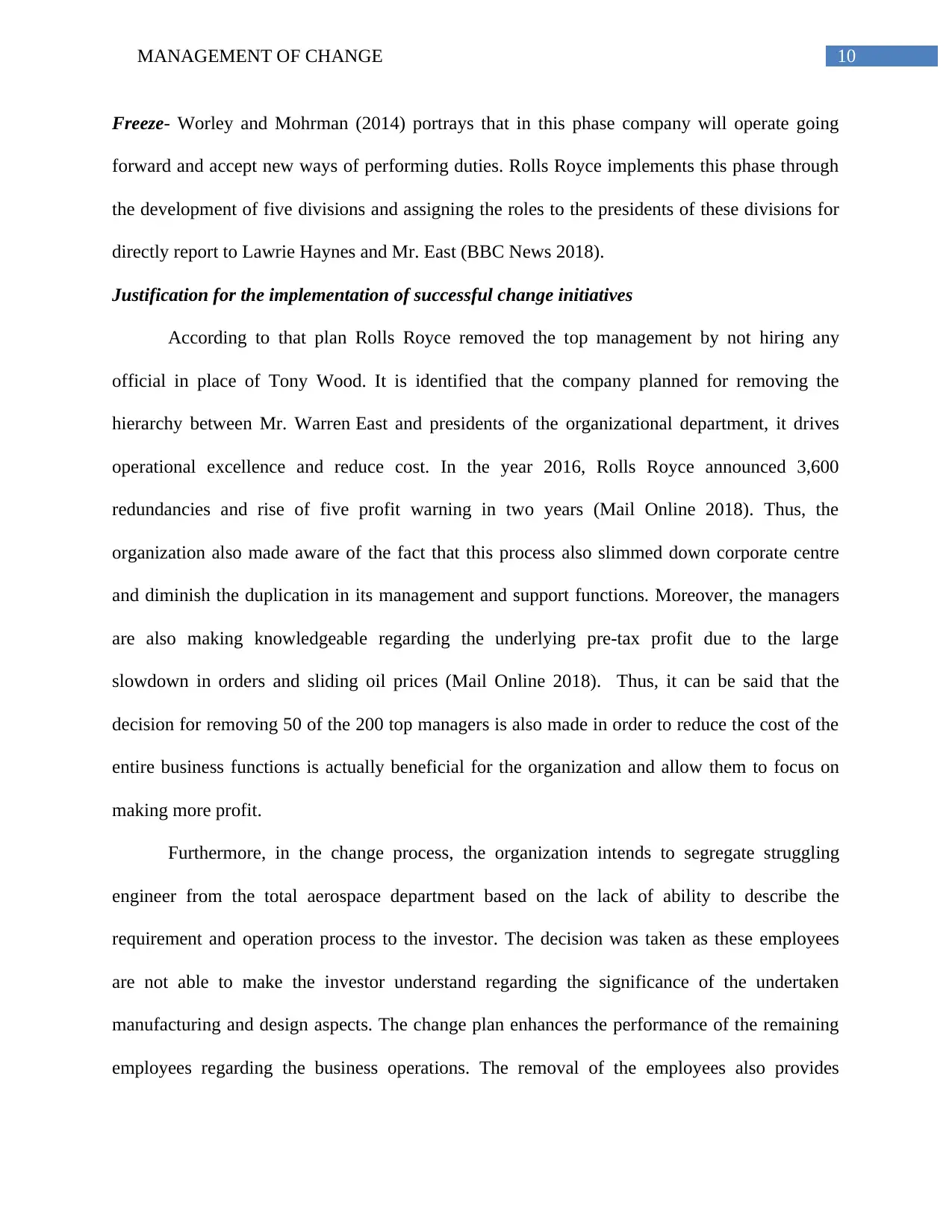
10MANAGEMENT OF CHANGE
Freeze- Worley and Mohrman (2014) portrays that in this phase company will operate going
forward and accept new ways of performing duties. Rolls Royce implements this phase through
the development of five divisions and assigning the roles to the presidents of these divisions for
directly report to Lawrie Haynes and Mr. East (BBC News 2018).
Justification for the implementation of successful change initiatives
According to that plan Rolls Royce removed the top management by not hiring any
official in place of Tony Wood. It is identified that the company planned for removing the
hierarchy between Mr. Warren East and presidents of the organizational department, it drives
operational excellence and reduce cost. In the year 2016, Rolls Royce announced 3,600
redundancies and rise of five profit warning in two years (Mail Online 2018). Thus, the
organization also made aware of the fact that this process also slimmed down corporate centre
and diminish the duplication in its management and support functions. Moreover, the managers
are also making knowledgeable regarding the underlying pre-tax profit due to the large
slowdown in orders and sliding oil prices (Mail Online 2018). Thus, it can be said that the
decision for removing 50 of the 200 top managers is also made in order to reduce the cost of the
entire business functions is actually beneficial for the organization and allow them to focus on
making more profit.
Furthermore, in the change process, the organization intends to segregate struggling
engineer from the total aerospace department based on the lack of ability to describe the
requirement and operation process to the investor. The decision was taken as these employees
are not able to make the investor understand regarding the significance of the undertaken
manufacturing and design aspects. The change plan enhances the performance of the remaining
employees regarding the business operations. The removal of the employees also provides
Freeze- Worley and Mohrman (2014) portrays that in this phase company will operate going
forward and accept new ways of performing duties. Rolls Royce implements this phase through
the development of five divisions and assigning the roles to the presidents of these divisions for
directly report to Lawrie Haynes and Mr. East (BBC News 2018).
Justification for the implementation of successful change initiatives
According to that plan Rolls Royce removed the top management by not hiring any
official in place of Tony Wood. It is identified that the company planned for removing the
hierarchy between Mr. Warren East and presidents of the organizational department, it drives
operational excellence and reduce cost. In the year 2016, Rolls Royce announced 3,600
redundancies and rise of five profit warning in two years (Mail Online 2018). Thus, the
organization also made aware of the fact that this process also slimmed down corporate centre
and diminish the duplication in its management and support functions. Moreover, the managers
are also making knowledgeable regarding the underlying pre-tax profit due to the large
slowdown in orders and sliding oil prices (Mail Online 2018). Thus, it can be said that the
decision for removing 50 of the 200 top managers is also made in order to reduce the cost of the
entire business functions is actually beneficial for the organization and allow them to focus on
making more profit.
Furthermore, in the change process, the organization intends to segregate struggling
engineer from the total aerospace department based on the lack of ability to describe the
requirement and operation process to the investor. The decision was taken as these employees
are not able to make the investor understand regarding the significance of the undertaken
manufacturing and design aspects. The change plan enhances the performance of the remaining
employees regarding the business operations. The removal of the employees also provides
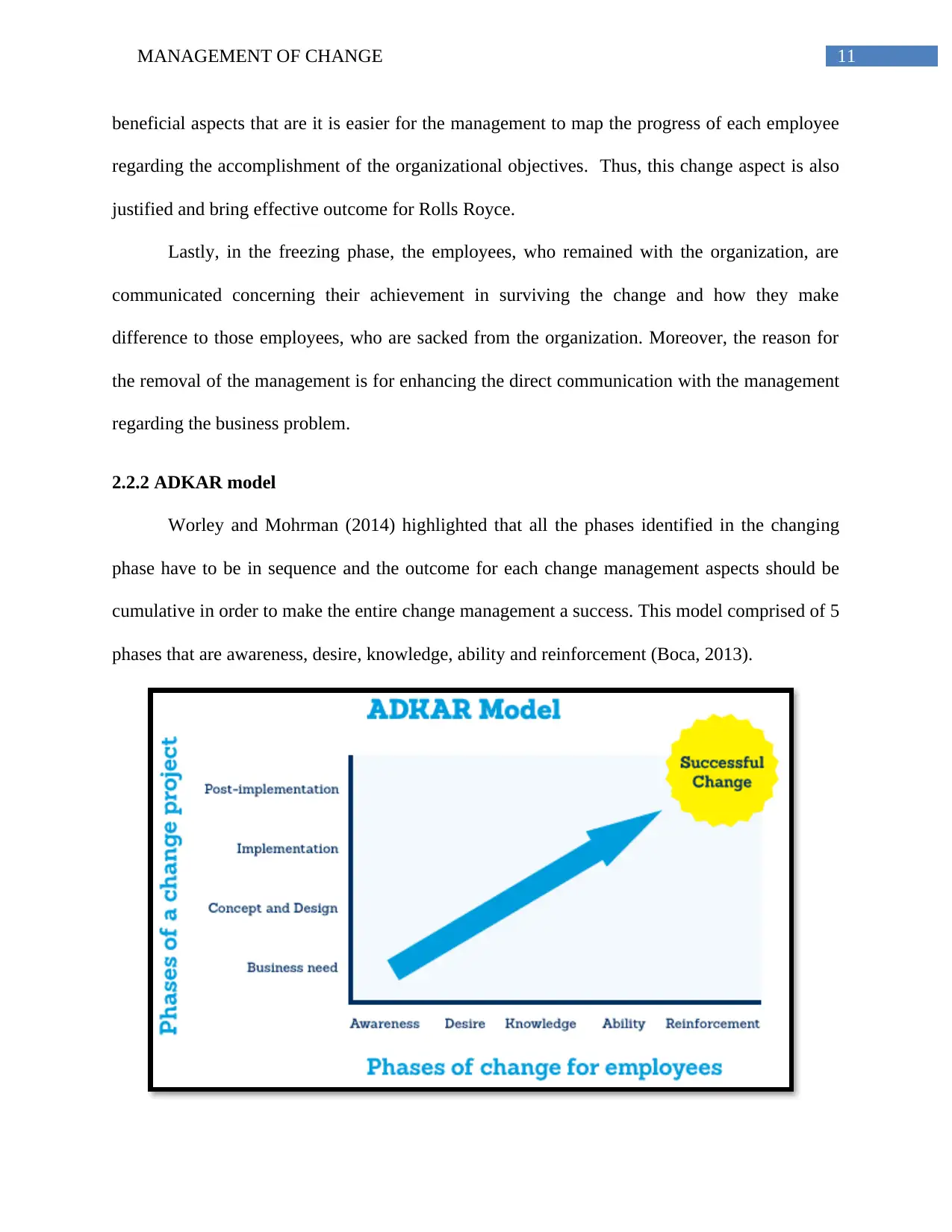
11MANAGEMENT OF CHANGE
beneficial aspects that are it is easier for the management to map the progress of each employee
regarding the accomplishment of the organizational objectives. Thus, this change aspect is also
justified and bring effective outcome for Rolls Royce.
Lastly, in the freezing phase, the employees, who remained with the organization, are
communicated concerning their achievement in surviving the change and how they make
difference to those employees, who are sacked from the organization. Moreover, the reason for
the removal of the management is for enhancing the direct communication with the management
regarding the business problem.
2.2.2 ADKAR model
Worley and Mohrman (2014) highlighted that all the phases identified in the changing
phase have to be in sequence and the outcome for each change management aspects should be
cumulative in order to make the entire change management a success. This model comprised of 5
phases that are awareness, desire, knowledge, ability and reinforcement (Boca, 2013).
beneficial aspects that are it is easier for the management to map the progress of each employee
regarding the accomplishment of the organizational objectives. Thus, this change aspect is also
justified and bring effective outcome for Rolls Royce.
Lastly, in the freezing phase, the employees, who remained with the organization, are
communicated concerning their achievement in surviving the change and how they make
difference to those employees, who are sacked from the organization. Moreover, the reason for
the removal of the management is for enhancing the direct communication with the management
regarding the business problem.
2.2.2 ADKAR model
Worley and Mohrman (2014) highlighted that all the phases identified in the changing
phase have to be in sequence and the outcome for each change management aspects should be
cumulative in order to make the entire change management a success. This model comprised of 5
phases that are awareness, desire, knowledge, ability and reinforcement (Boca, 2013).
⊘ This is a preview!⊘
Do you want full access?
Subscribe today to unlock all pages.

Trusted by 1+ million students worldwide
1 out of 23
Related Documents
Your All-in-One AI-Powered Toolkit for Academic Success.
+13062052269
info@desklib.com
Available 24*7 on WhatsApp / Email
![[object Object]](/_next/static/media/star-bottom.7253800d.svg)
Unlock your academic potential
Copyright © 2020–2025 A2Z Services. All Rights Reserved. Developed and managed by ZUCOL.




